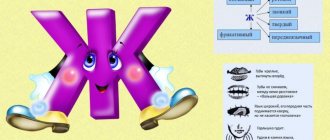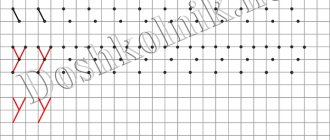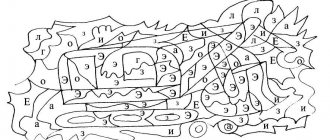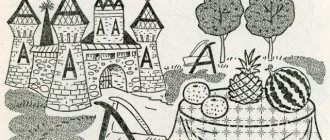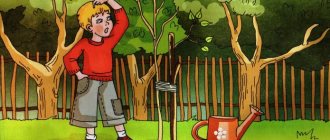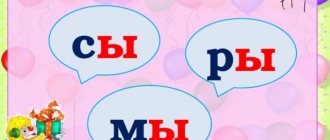Why the child does not pronounce the sound “r”: reasons
Before drawing conclusions about the reason why it is difficult for a child to pronounce the sound r, an examination of the speech apparatus, a hearing test, and sometimes a consultation with a neurologist is necessary:
- Short sublingual frenulum. At five years its length reaches 7-8 mm. These sizes allow the tongue to rise. If it is thick and short, the specialist suggests stretching exercises or sends it for trimming.
- The pronunciation algorithm is broken - incorrect automation of the sound “r” in words: instead of “r” he says “l” or hissing words. If it is easier for a child to insert “l” into words than to pronounce the letter “r”, the process of making the correct sound will go faster: the pronunciation algorithm is similar. If the child replaces it with hissing words, a phonemic hearing test is needed.
- The child does not hear individual sounds - phonemic hearing is impaired. It is difficult for him to distinguish them, so he replaces them or skips them altogether. The reasons for this disorder are problems with the central nervous system, adenoiditis and otitis media.
- The articulatory apparatus is in good shape or completely relaxed. Lips, cheeks and tongue are tense or not mobile enough. Both prevent the child from learning to pronounce the letter “r” correctly. Then the speech therapist offers articulation exercises.
- Behavior problems. To teach a child to pronounce a letter, a specialist must be able to interest in exercises for the letter r, and the child must be able to maintain attention during the training process. Disinhibition or passivity prevents him from concentrating. The reasons are neurological disorders or an unhealthy atmosphere in the environment of a child who is deprived of close emotional contact with the parent.
- Throat pronunciation. Instead of tension of the tongue and frenulum, the child’s laryngeal uvula vibrates. When pronounced in a throaty manner, they say that the child is burring. The correction is difficult for 2 reasons: parents come late because they do not distinguish between lingual and throat sounds, and also because it is necessary not just articulatory gymnastics to produce the r sound, but to gradually teach how to pronounce it according to a new algorithm.
Riddles for children starting with the letter P
Along the wave, along the wave Music floats towards me. (Radio)
There is a beautiful chest, You can’t touch it - it’s silent. And as soon as you turn the hands, He will speak and sing. (Radio)
The painted rocker hung above the river. (Rainbow)
People live under water and walk backwards. (Crayfish)
Not a feather, not a wing, But faster than an eagle. As soon as it releases its tail, it will rush to the stars. (Rocket)
It is bitter in haymaking, and sweet in frost. What kind of berry? (Rowan)
My cheeks are red, my nose is white, I sit in the dark all day, And my shirt is green, It’s all in the sun. (Radish)
Runs in the summer. Sleeps in winter. Spring has come - I'm running again. (River)
It flows, it flows, it won’t flow out, it runs, it runs, it won’t run out. (River)
He has a lot of teeth, but he doesn't eat anything. (Comb)
You enter through one door and exit through three. You think you left, but in fact you entered. (Shirt)
The steel pipit runs across the white field, leaving black tracks behind it. (Pen)
Round, but not a ball, Yellow, but not butter, Sweet, but not sugar, With a tail, but not a mouse. (Turnip)
A new vessel, but it’s all full of holes. (Sieve)
Whoever touches him clings to him. (burdock)
In the morning the beads sparkled and covered all the grass. And we went to look for them during the day - We search and search, but we won’t find them. (Dew)
Four guys are sitting in one fur coat, and the fifth is in a fur coat and stands aside. (Hands in mittens)
I’m not sitting on a horse, but on a tourist’s back. (Backpack)
Autumn has come to our garden. The red torch was lit. Here blackbirds and starlings scurry about, And, noisily, they peck at him. (Rowan)
How to distort the letter "r"
On specialized resources Rotacism the following main variants of distortion of the sound “r”, or scientifically called rotacism, are described:
- Burr, or throaty “r”. It is not the tip of the tongue that vibrates, but the soft palate. This pronunciation is normal for French and German, but not for Russian speech.
- Lateral "r". One side of the tongue is pressed against the upper teeth, the other side hangs down, and the tip does not vibrate. The result is something similar to “rl”.
- Single-stroke "r". Instead of vibrating, the tip of the tongue hits the hard palate once, forming something like the English r.
- Nasal "r". When you exhale, the air flow does not pass through the mouth, but through the nose. In addition, the tip of the tongue is pulled back and does not participate in articulation. The phrase “Roma, open the doors!” will turn into “Ngoma, otkngoy dvengi!”
- Kuchersky "r". And again, the vibration occurs in the wrong place, namely on the lips close together. The baby makes something similar to “whoa.”
- Pararotacism, or replacement of “r” with another sound. Instead of “child” you hear “child”, “hebyonok”, “vebyonok”, “yaebyonok” or even “yebyonok”.
- Missing "r". The kid simply avoids difficulties. He says not “fish”, but “yba”, not “glad”, but “hell”, not “thunder”, but “gom”.
Why is it difficult to growl?
The sound "r" is considered one of the most difficult to reproduce. To pronounce it correctly, you need:
- raise the tip of the tongue to the upper teeth - while it should remain spread out, like a pancake, and not narrow from tension;
- As you exhale, direct a powerful air stream to the tip so that vibration occurs.
For such manipulations, the child needs a developed speech apparatus, a strong tongue root and frenulum. Usually all this is formed by the age of six.
How is the lesson going?
The lesson always begins with a greeting and creating a pleasant but working atmosphere. Good afternoon guys. I'm very glad to see you all. Come on, and you will smile at each other and say “hello.” Now we will quietly sit down in our seats and begin the lesson.
Definition of the sound "r" in words
Today we will get acquainted with the new letter and sound “R”. Let’s remember how letters differ from sounds? The letter can be seen and written, and the sound can be heard and pronounced. Our guest is Dunno, who also wants to be literate. I’ll read him a few riddles, and you help Dunno guess them:
- A strange beast lives at the bottom, walks backwards. (Cancer)
What is the first sound in the guess word? It can be hard - “Cancer.” Rainbow”, or can be pronounced softly – “River”.
- Coloring – grayish, Habit – furtive, Screamer hoarse, Famous person. Who is she? (Crow)
As a crow talks, let's say it together: kar-rr... Is the sound “R” voiced or unvoiced? Is it consonant or vowel? Let's denote it with a blue circle.
Children must distinguish the sound “R” and clap their hands:
- among isolated sounds: D, M, R, Zh, Z, R, R, G, R;
- among the syllables: KO, MI, RU, VA, RE, OR, PA, IR;
- Among the words: moon, cake, cat, summer, crucian carp, child, spoon, mask, TV.
Articulation exercises
Take the mirrors and stretch the tongue:
- Let's cluck like horses. We press our tongue to the roof of our mouth and slowly pull it back to make a click. Repeat 10 times.
- We ate delicious raspberry jam. Let's relax the tongue so that it becomes wide, stick it out, lick the upper lip and hide it. Repeat 10 times.
- Let's roar like a motor. The tip of the tongue should be hidden behind the upper teeth, the teeth should be slightly unclenched. We exhale a stream of air, working with the “throat”.
First slowly, then speeding up the pace, we repeat the tongue twister: “Roma was scared of the thunder, he roared louder than thunder.”
Looking in the mirror, we learn the articulatory production of sound. The tip of the tongue is slightly pressed against the tubercles behind the upper row of teeth. The lateral surfaces of the tongue are in contact with the molars. In this position, the tongue resembles a “spoon” in shape. The air is exhaled with pressure so that the tip of the tongue vibrates. The sound is pronounced with the voice.
Sound R - staging and automation
Pronouncing syllables
Continuing to control the movement of the tongue in the mirror, the sound series is spoken:
RA – RA – RA
RU – RU – RU
RO - RO - RO
You can ask the children to complete a syllable to a whole word, for example:
RU – Hand
RY - Fish
RO - Chamomile.
Warm-up
Alternating learning with outdoor games improves the perception of the material, but it is worth maintaining the focus of the lesson.
- Children stand around the teacher, imitate playing the drum, starting at a slow tempo, gradually speeding up the rhythm and increasing the strength of their voice: TARA - TARA - TARARAM.
- A poem is being read. When children hear a word with the letter “P,” they jump.
- Divide the children into two teams: “crows” and “wolves”. Crows fly, flapping their wings and cawing loudly. Wolves run into the circle growling and catch the crows. Those who are caught sit down in their places.
Parsing a letter into parts, working with a split alphabet
What does the letter "R" consist of? This is a stick with a semicircle attached to the upper half. Children draw a letter in the air, then fold it out of a paper constructor, and try to write in printed font in a notebook.
From the syllables of the split alphabet you need to make words where the letter “P” is located:
- at the beginning: fish, river, frame, radio;
- at the end: ball, painter, mosquito, carpet;
- in the middle: pie, crow, tree.
Now let’s count how many syllables are in a certain word and write the number in a notebook. Let's each come up with one sentence with any word we like. Let's name the animals that have the letter "R" in their names. Where, in what part of the word, is it located?
Summing up
Let's tell Dunno what letter and sound we learned today. Is it consonant or vowel? What color should we use to mark it? What does a hard sound sound like, what does a soft sound sound like? Well done!
Related posts:
- Teaching a child to read Teaching reading in preparation for school. When can you teach a child...
- History, signs and symptoms of dysgraphia Symptoms of dysgraphia in children and methods of overcoming it depend on ...
- What do we know about Morse code? Morse code was created to transmit short information. But use...
- The sound “Zh” - from production to automation Automation of the sound “Zh” begins with identifying the reasons that interfere with the correct sound pronunciation...
Assignment: Printed letter P for preschoolers
Look at the letter P, write it in the air. Draw a stick (vertical) and turn it into the letter R.
In cases where the child is asked to write a whole line of a letter, syllable or word, the adult gives a writing sample at the beginning of the line. If a preschooler has difficulties, then an adult can draw two approximate lines, or put reference points that the child will connect with lines, or write the entire letters, and the child will simply circle them in a different color. Calligraphy should not be required at this stage of training.
Print
What prevents you from pronouncing the letter “r” correctly?
Even with prepared instruments in their mouths, preschoolers manage to distort the ill-fated sound. And there are several reasons for this.
Short hypoglossal ligament
It is also called a bridle. It prevents you from moving your tongue freely and lifting it up. Most often, the problem is discovered in the maternity hospital. If the hyoid ligament does not allow the baby to suckle normally, it is cut. At a later age, the frenulum is usually stretched with the help of speech therapy exercises.
Phonemic hearing disorder
Phonemic hearing is the ability to correctly perceive and reproduce speech sounds. Normally, by the age of three, a child can already discern the difference between similar sounds, even if he does not know how to pronounce them.
Sometimes the development of phonemic hearing is delayed due to previous otitis media, adenoids or other health problems. As a result, sound analysis and synthesis are disrupted: the child hears the sound incorrectly, misses it in speech, or replaces it with another.
Incorrect speech breathing
To pronounce correctly, you need to be able to control your exhalation. Not all children succeed in this: some raise their shoulders while inhaling, others breathe too shallowly and unevenly, or do not know how to distribute the exhalation according to words.
Deep bite
With a correct bite, the upper front teeth overlap the lower ones by about a third, and the rest close together. But if the bite is too deep, the upper ones cover the lower ones by more than half. It becomes more difficult to achieve the correct position of the tongue with the emphasis on the upper teeth.
A tale about the letter R
Red-haired city One boy was teased with red hair. This boy was very worried and decided to leave home, no matter where. He went to bed early and had a dream: as if he had already left home and was walking wherever his eyes led him. He looks - the gates are standing, and on them is written:
“Welcome to Red City!” He entered and gasped.
In this amazing city, everything was red-red. Red streams flowed through red grasses and flowed into red rivers. And red rainbows hung over the rivers. Red fishermen caught fish and crayfish in these places. “The Red Waltz” was broadcast on the radio, and all the red-haired people smiled joyfully. Then a red-haired girl approached him:
"Why are you so sad?" “Everyone teases me about being a redhead,” the boy answered gloomily. “How stupid,” the girl laughed. “Come on, look at the sun, what color is it?” “Well, red,” the boy said timidly. “And we are red! This means that we are all little suns. You should be happy!..”
And then the boy woke up. He ran out into the yard, and the boys were right there: “Red-haired, red-haired, freckled!” And he just laughed and slyly winked at the red sun...
(G. Yudin)
Funny poems about the letter P for children
Eraser I am an eraser, I am an eraser, Little grimy back. But my conscience is clear: I erased the blot from the sheet! (V. Berestov)
Crow - Kra! - the crow screams. - Theft! Guard! Robbery! The missing! The thief sneaked in early in the morning! He stole the brooch from his pocket! Pencil! Cardboard! Traffic jam! And a beautiful box! - Stop, crow, don’t scream! Don't shout, be quiet! You can't live without deception! You don't have a pocket. - How! — The crow jumped up and blinked in surprise. - Why didn’t you say it before?! Car-r-raul! Car-r-rman stole! (V. Orlov)
For a fish, cancer is neither a friend nor an enemy. Fish are unlikely to be afraid of cancer. The fish is afraid of the worm that is attached to the hook. (V. Lunin)
Ruff gave a gun loaded with a cork to a timid fish. Since then, the pugnacious black cancer has not started fights with her. (G. Satir)
Together with the golden cloud, the bugler wakes up. Vociferously, vociferously, the bugler sings: “The grass in the meadow is not crushed! The sun looks into the river! Let's exercise, guys! Get ready!” (V. Levin)
Pen Printed letters Very neat. Letters for writing I write myself. It's very fun to write with a pen: The letters hold each other's pens. (V. Berestov)
What's growing in our garden bed? Cucumbers, sweet peas, tomatoes and dill For seasoning and for testing. There are radishes and lettuce - Our garden bed is a treasure. But watermelons don't grow here. If you listened carefully, you would definitely remember. Answer in order: What grows in our garden bed? (V. Korkin)
About the letter R The letter R is lost. Where? On a tram, for example. Or didn't we pick her up from the yard yesterday? Dropped in a grocery store, Didn't find it behind the door in the house? Or hidden (check!) in a printed envelope? Maybe the policeman will give us the letter R? But Masha said loudly: “Our letter has been found!” Look how simple it is: Fish! Cancer! River! Rocket! (V. Tvorogova)
Why? I won’t tell anyone why tigers growl: “Gar-r-r”, Crows shout: “Car-r-r”, Horses wheeze: “Hr-r-r”, Shutters creak: “Skr-r-r”. I won't tell anyone. Why does Kenar sing: “Tew-ir-r-r”, A helicopter flies: “Dr-r-r”, A tractor roars: “Tr-r-r”, A boat floats: “Shrr-r-r”. And no one will guess. That Tigers growl, Crows scream, Shutters creak, Horses snore, To teach all the children to pronounce the difficult “r-r-r-r”!.. (P. Vysotsky)
Olesik's Trouble Olesik always had trouble with the letter "er". Says “cancer” - comes out “varnish”. Instead of "rye" - it turns out to be "lie". A puppy who was angry. He learned to growl. And now, in spite of misfortune, He pronounces “er” everywhere: “Crocodir” and “Morotok”, “Moroko” and “boxes”. At the zoo there is “roar” and “rvitsa”... Who can we learn “el” from? (N. Timchak)
We fly apart, we fly together. We roller skate. Cheerful dancers, Frisky like meteors. (V. Berestov)
Crayfish, oh, and bullies! They can't do without a fight. Every now and then they start fights among themselves. (F. Bobylev)
Thundered over the black cloud, Roared over the red steep, Let thunder rumble in the mountains! Let's go for a walk anyway! (S. Pogorelovsky)
When to take your child to a speech therapist
It is advisable to do this before the baby goes to school. Otherwise, a problem with the pronunciation or perception of “r” may affect your studies or communication with peers.
How long will the correction take? Everything is very individual: for some, three or four sessions with a specialist are enough, while others need months of regular training at home under the supervision of a speech therapist. In any case, in adulthood, the process of correcting speech errors will require much more time and effort than at 6–7 years old.
